Authentic & Easy Vegan Thai Green Curry Recipe (Creamy & Flavorful)
Prepare to tantalize your taste buds with this incredible vegan Thai green curry! It’s a dish that perfectly balances a delightful kick of spice with a rich, creamy, and deeply satisfying flavor profile. Bursting with an array of colorful vegetables and a luxurious coconut base, this plant-based curry is a true comfort food that pairs beautifully with fluffy jasmine rice or your grain of choice. Whether you’re a seasoned vegan chef or new to plant-based cooking, this recipe offers a straightforward path to an authentic and incredibly delicious meal.
This recipe was originally published on February 12, 2021. It was updated with new information and expanded content on December 30, 2023, to provide even more value and enhance your cooking experience.
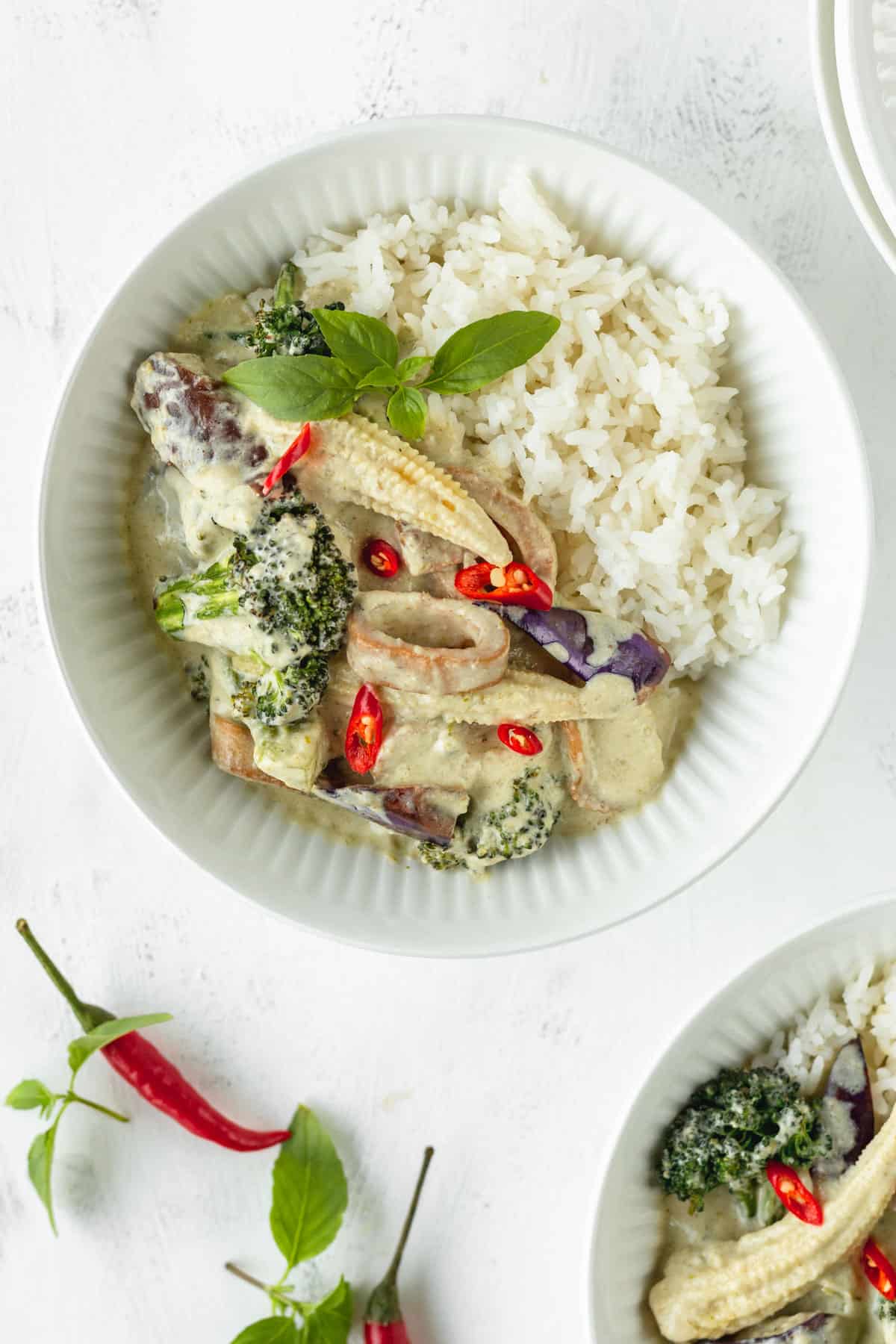
This post is proudly sponsored by Chef’s Choice. All text and opinions expressed are entirely my own, ensuring an honest review of products I genuinely use and love.
Why You’ll Love This Vegan Thai Green Curry
This recipe isn’t just another meal; it’s an experience waiting to happen in your kitchen. Here are just a few reasons why this vegan Thai green curry will become a staple in your rotation:
- Unforgettable Flavor: We’re talking about that perfect blend of spicy, sweet, savory, and umami that defines authentic Thai cuisine, all in a plant-based package.
- Quick & Easy: Thanks to readily available ingredients and a simple cooking process, this impressive dish comes together in under an hour, making it perfect for busy weeknights.
- Healthy & Wholesome: Loaded with fresh vegetables and wholesome ingredients, it’s a nutrient-packed meal that will leave you feeling satisfied and energized.
- Highly Customizable: Don’t have a specific vegetable on hand? No problem! This recipe is incredibly versatile, allowing you to use your favorite seasonal produce or experiment with different vegan proteins.
- Creamy & Comforting: The rich coconut milk base creates a velvety texture that’s wonderfully comforting, especially on a chilly evening.
Understanding Thai Green Curry
Thai green curry, known as “Gaeng Keow Wan” in Thai, literally translates to “sweet green curry.” This name might be misleading for some, as it’s often the spiciest of the Thai curries, deriving its vibrant color and heat from fresh green chilies. Traditional green curry paste is a complex blend of herbs and spices, typically including green chilies, shallots, garlic, galangal, kaffir lime zest, coriander root, cumin, and white peppercorns. Our vegan adaptation stays true to these aromatic roots while carefully selecting plant-based ingredients to achieve the same depth of flavor without any animal products. The richness comes from full-fat coconut milk, creating a harmonious balance that is both exotic and familiar.
Essential Ingredients for Your Vegan Green Curry
Crafting a truly exceptional vegan Thai green curry begins with selecting the right ingredients. Each component plays a vital role in building the layered flavors that make this dish so special.
- Green Curry Paste: This is the heart of your curry. While traditional green curry pastes often contain shrimp paste, many excellent vegan brands are now available. Look for brands like Chef’s Choice or Aroy-D, which consistently offer high-quality, authentic vegan options. Always double-check the ingredient list to ensure it’s free from any animal-derived products. A good quality paste makes this curry incredibly quick and easy to prepare, delivering deep, complex flavors without the need for an extensive spice grind from scratch.
- Coconut Oil: Used for sautéing your vegetables and toasting the curry paste, coconut oil adds a subtle, fragrant undertone that complements the overall coconut flavors of the curry. If you opt for virgin coconut oil, its distinct aroma will further enhance the tropical notes. Alternatively, neutral oils like grapeseed oil, vegetable oil, or light olive oil can be used.
- Full-Fat Coconut Milk: This is crucial for achieving the signature creamy texture and rich flavor of a Thai coconut curry. Do not use low-fat versions, as they won’t provide the same luxurious mouthfeel or depth. Canned full-fat coconut milk is essential here.
- Fresh Vegetables: The beauty of this vegan curry lies in its versatility with vegetables. I love using a mix of eggplant (which soaks up the flavors beautifully), tender broccoli florets, and crisp baby corn. For a unique touch, I’ve included Nature’s Charm vegan calamari, made from king oyster mushrooms, which offers a delightful texture similar to its seafood counterpart. Feel free to customize with your favorites: bell peppers, bamboo shoots, carrots, snap peas, spinach, or kale are all fantastic additions.
- Vegetable Stock: This forms the liquid base of your curry, helping to create the perfect consistency and deepen the savory notes. I highly recommend using a reduced-sodium vegetable stock or broth, allowing you to precisely control the overall saltiness of your dish and ensure the flavors are perfectly balanced.
- Salt: Depending on the sodium content of your curry paste and vegetable stock, you may need to add extra fine sea salt to taste. It’s all about balancing the flavors, so always taste and adjust.
- Sugar: A touch of sugar (often palm sugar in authentic Thai cuisine, but granulated sugar works perfectly) is vital to mellow out the spiciness of the green curry paste and harmonize all the flavors. It brings a subtle sweetness that rounds out the dish without making it overtly sweet.
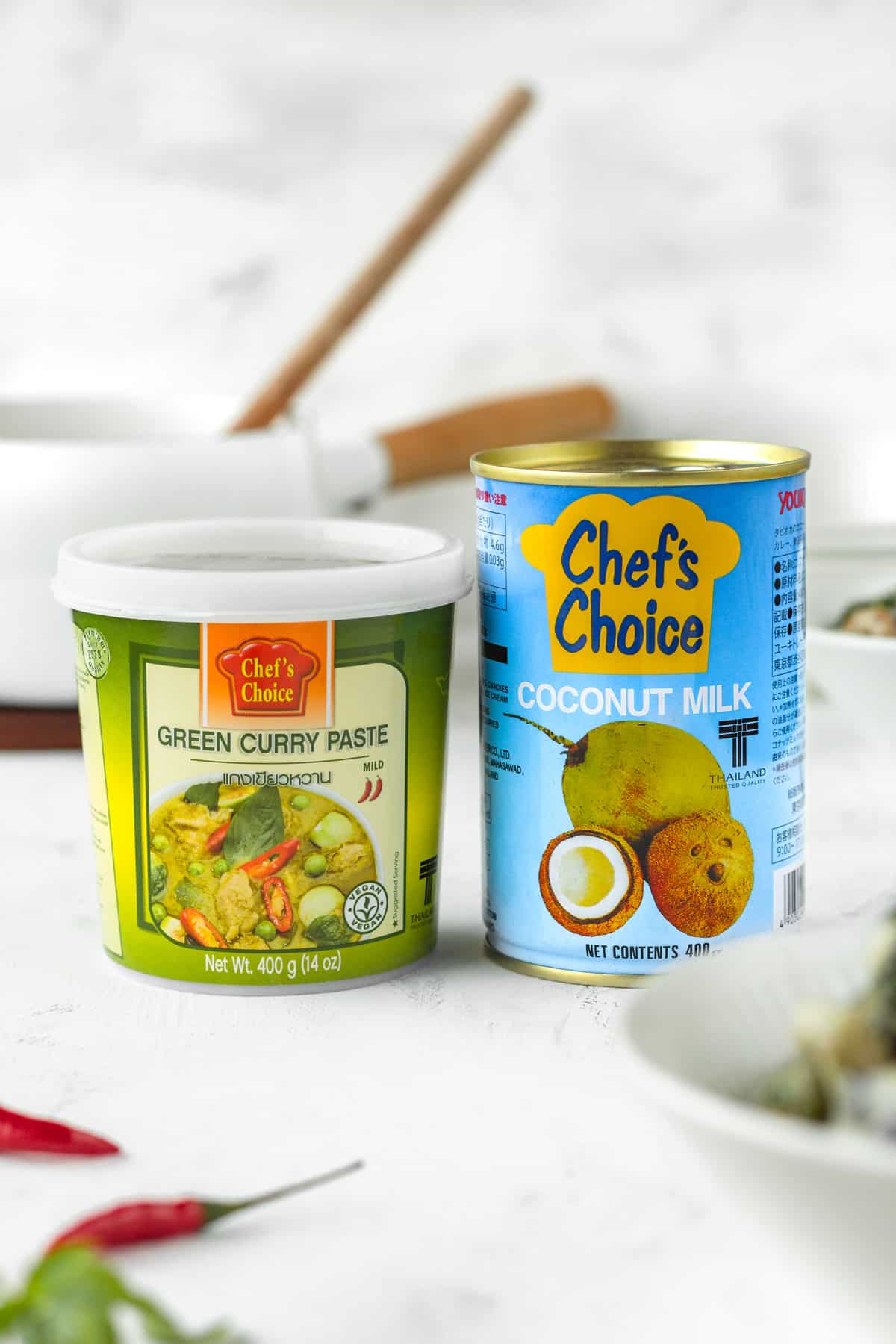
Step-by-Step: Crafting Your Delicious Vegan Green Curry
Follow these straightforward steps to create a flavorful and aromatic vegan Thai green curry that will impress every time:
Step 1: Prepare Your Vegetables. Begin by thoroughly rinsing your mushrooms (or vegan calamari) and all chosen vegetables. Chop them into bite-sized pieces suitable for curry. Pat them dry with a paper towel; this step is important for achieving a good sear when sautéing.
Step 2: Sauté the Mushrooms. Heat 1 tablespoon of coconut oil in a large skillet or wok over medium heat. Add your chopped mushrooms or vegan calamari and sauté until they are lightly browned and have a slightly crispy texture. Remove them from the skillet and set aside on a plate. Sautéing them separately ensures they cook evenly and develop a rich, earthy flavor.
Step 3: Sauté Remaining Vegetables. Add another 2 tablespoons of coconut oil to the same skillet. Once hot, add the broccoli florets and cubed eggplant. Sauté these until they are lightly browned and tender-crisp. Transfer them to the plate with the mushrooms. This staggered cooking ensures each vegetable maintains its ideal texture.
Step 4: Build the Curry Base. In a deep saucepan or Dutch oven, heat 1 tablespoon of coconut oil over medium heat. Add the green curry paste and sauté for 1-2 minutes, stirring continuously. This step is crucial as it “toasts” the paste, releasing its full aromatic potential and deepening its flavor. Once fragrant, slowly pour in the full-fat coconut milk, stirring well to combine with the paste.
Step 5: Simmer and Season. Bring the coconut milk mixture to a gentle boil. Once bubbling, add the vegetable stock, water, all the previously sautéed mushrooms and vegetables, and the baby corn. Let the curry return to a boil, then immediately reduce the heat to a simmer. Allow it to gently simmer for about 5 minutes, or until the vegetables reach your desired tenderness and the curry has thickened slightly. Finally, taste the curry and add salt and sugar to your preference, adjusting the balance of spicy, sweet, and savory.
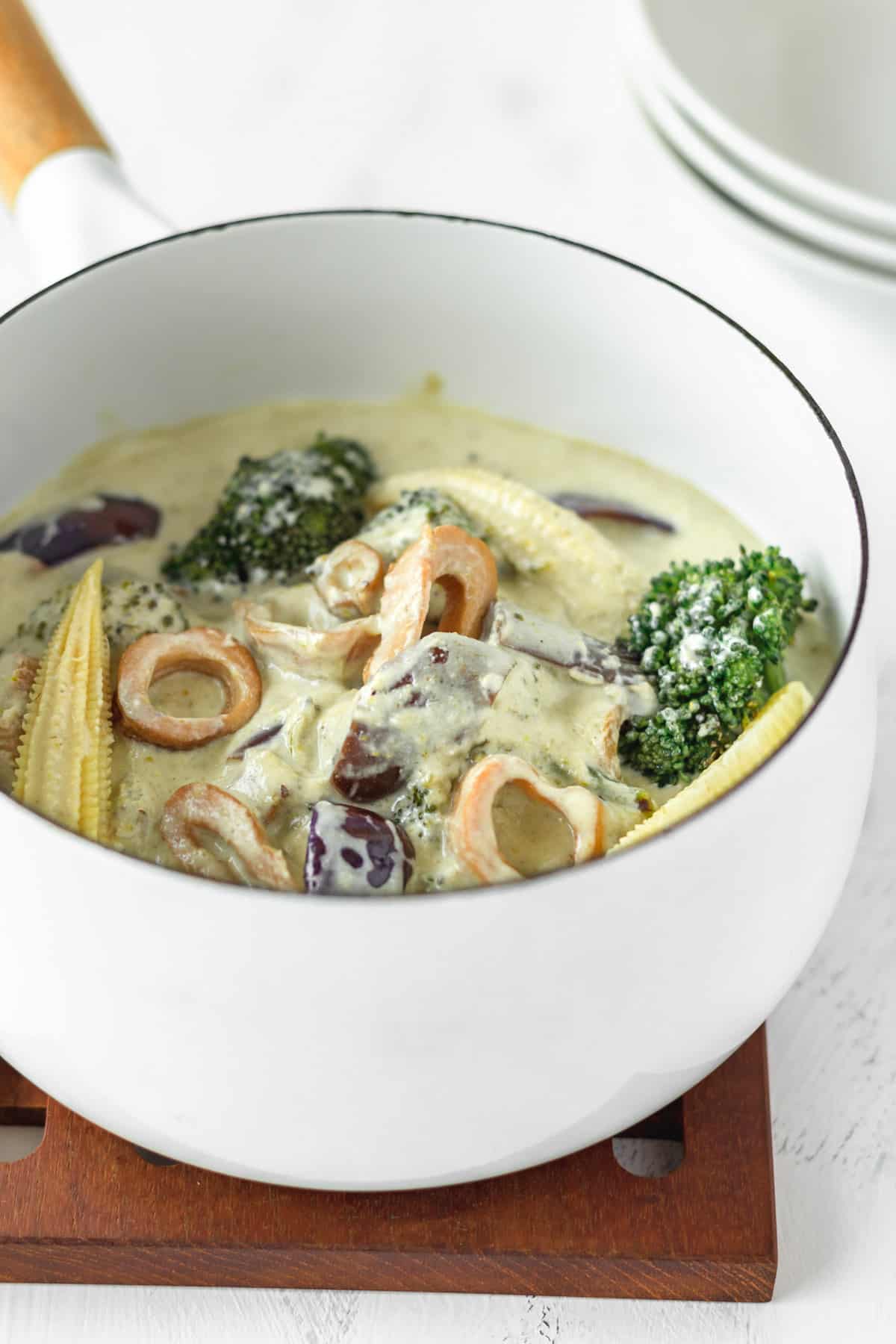
Expert Tips for a Restaurant-Quality Vegan Thai Green Curry
Elevate your homemade vegan Thai green curry to new heights with these pro tips:
- Invest in Quality Curry Paste: The flavor of your curry heavily relies on the paste. Seek out high-quality vegan Thai green curry paste from reputable brands. Reading labels is crucial to ensure it’s genuinely vegan (free from shrimp paste or fish sauce).
- Always Use Full-Fat Coconut Milk: For that rich, authentic creaminess, full-fat canned coconut milk is non-negotiable. It provides the luxurious texture and deep flavor that lighter versions simply can’t replicate.
- Let the Flavors Mellow: If you find the curry a bit too spicy or the flavors are not fully integrated right after cooking, let it rest off the heat for 10 to 30 minutes before serving. This allows the flavors to meld and develop, resulting in a more harmonious dish.
- Embrace Pre-Cut Vegetables for Speed: Short on time? Don’t hesitate to grab pre-cut vegetables from your grocery store’s produce section. This simple hack can drastically reduce your prep time, making this a truly fast weeknight meal.
- Customize to Your Heart’s Content: This vegan curry recipe is incredibly versatile. Feel free to switch up the vegetables based on what’s in season or what you have on hand. Beyond mushrooms, consider adding grilled or pan-fried tofu, tempeh, or chickpeas for extra protein and texture.
- Season Generously and to Taste: Always taste your curry before serving. You might want to add a pinch more salt to enhance the savory notes or a little more sugar to mellow the spice and balance the overall flavor profile. A squeeze of fresh lime juice at the end can also brighten everything up.
- Don’t Overcrowd the Pan: When sautéing vegetables, cook them in batches if necessary to avoid overcrowding. Overcrowding leads to steaming instead of browning, and you want those delicious caramelized edges.
- Adjust Consistency: If your curry is too thick, add a splash more vegetable stock or water until it reaches your desired consistency. If it’s too thin, let it simmer uncovered for a few extra minutes to reduce.
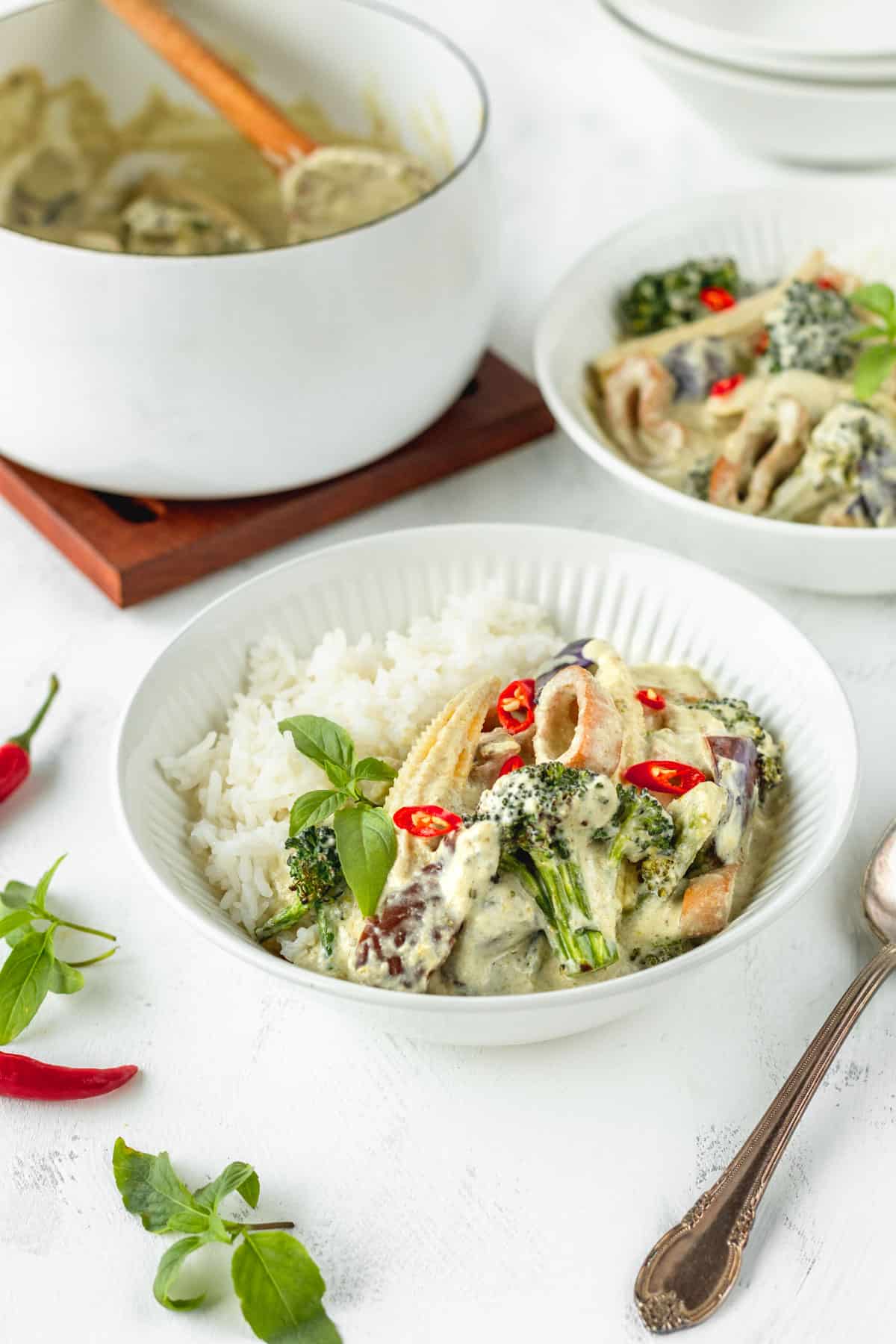
Serving Suggestions for Your Vegan Thai Green Curry
This vibrant vegan green curry is a complete meal on its own, but it truly shines when served with the right accompaniments:
- Jasmine Rice: The classic pairing! Its fragrant aroma and fluffy texture perfectly absorb the rich curry sauce.
- Brown Rice or Quinoa: For a healthier, whole-grain option, brown rice or quinoa provides a nutty flavor and added fiber.
- Rice Noodles: If you prefer a noodle dish, serve the curry over cooked thin rice noodles (vermicelli) or wider flat rice noodles.
- Cauliflower Rice: A fantastic low-carb alternative that still soaks up all the delicious flavors.
- Fresh Herbs: Garnish generously with fresh cilantro, Thai basil, or a squeeze of lime juice for an extra burst of freshness and aroma.
- Additional Spice: For those who love extra heat, offer sliced fresh red chilies or a dash of chili oil on the side.
Make Ahead & Storage Guide
This vegan Thai green curry is fantastic fresh, but it also makes for wonderful leftovers, with flavors often deepening overnight. Planning ahead or storing extra portions is simple!
Refrigeration: To store your vegetable curry, allow it to cool completely before transferring it to an airtight container. It will keep beautifully in the fridge for 3 to 4 days. When ready to enjoy, you can gently reheat it in a saucepan on the stovetop over medium-low heat until warmed through, or simply portion some into bowls and reheat in the microwave.
Freezing: For longer storage, this curry freezes well! Place leftover curry in an airtight freezer-safe container or a heavy-duty freezer bag, ensuring there’s minimal air. It can be stored in the freezer for up to 3 months. When you’re ready to eat, remember to let it thaw in the fridge overnight before reheating on the stovetop or in the microwave for the best results.
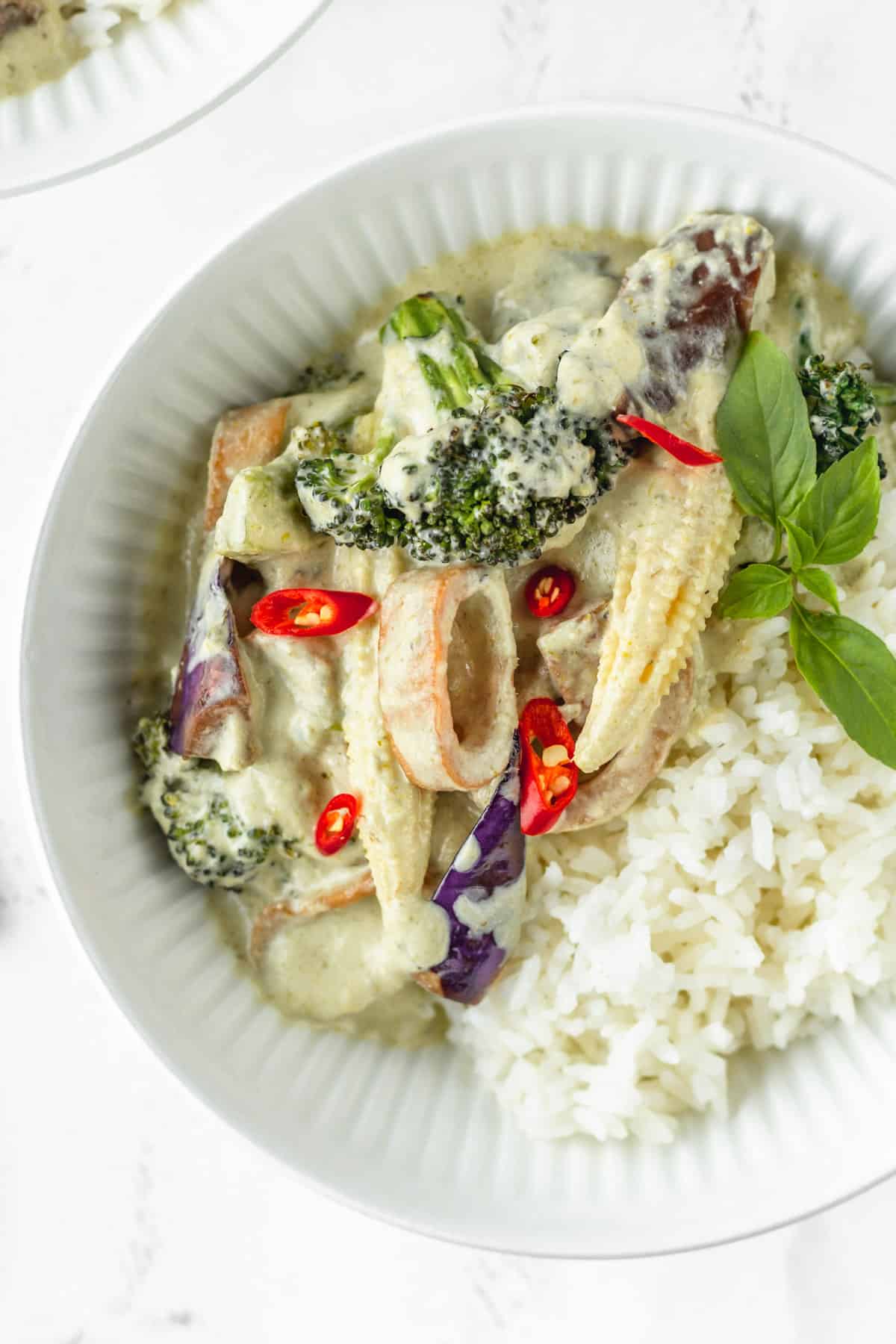
Frequently Asked Questions About Vegan Thai Green Curry
When seeking a truly vegan Thai curry paste, it’s essential to check the ingredient list carefully, as many traditional pastes include shrimp paste or fish sauce. Excellent high-quality vegan options are available from brands like Chef’s Choice and Aroy-D. While Mae Ploy is a popular brand for authentic flavors, their green curry paste typically contains shrimp paste, making it unsuitable for a vegan diet. Thai Kitchen also offers vegan pastes, but some find their flavor to be milder compared to other more robust brands.
No, traditional Thai green curry is generally not vegan-friendly. Its authentic preparation typically involves key animal products such as shrimp paste (a fermented condiment central to the paste’s flavor) and often fish sauce in the curry base. Furthermore, it’s commonly served with non-vegan proteins like chicken, beef, or prawns. However, this specific Thai green curry recipe is meticulously crafted to be 100% vegan, omitting all animal products while retaining the rich, complex flavors you expect.
The spice level of any curry can depend on the chef’s preference and the specific recipe, but generally, green curry is often considered spicier than red curry. This is because green Thai curry is traditionally made with a larger quantity of young, fresh green chili peppers, which impart a vibrant heat. Red Thai curry, on the other hand, uses dried red chili peppers, which tend to offer a different, sometimes mellower, heat profile. Both are spicy in their own distinct ways, but green typically wins in terms of raw heat.
Absolutely! While the king oyster mushrooms provide a fantastic “calamari-like” texture, this vegan curry recipe is incredibly versatile. You can easily omit them or substitute them with other vegetables like bell peppers, zucchini, or even a firm vegan protein like pan-fried tofu or tempeh. The curry will still be utterly delicious and satisfying!
While many popular Thai curries, including green, red, and massaman curries, are famously made with coconut milk, not all Thai curries require it. There are many regional Thai curries, particularly from the northern and northeastern parts of Thailand, that are often water-based or use less coconut milk, focusing more on herbs, spices, and sometimes fermented fish or fermented bean paste for their base. However, for the creamy, rich curries widely enjoyed internationally, coconut milk is a defining ingredient.
The simplest way to thicken your Thai curry is by simmering it for a longer duration, uncovered, over medium-low heat. This allows excess liquid to evaporate, naturally reducing the sauce and concentrating its flavors. If you need a quicker solution, you can dissolve a small amount of cornstarch or arrowroot powder in a little cold water to create a slurry, then gradually whisk it into the simmering curry until it reaches your desired thickness. Be careful not to add too much, as it can alter the texture.
Yes, you can easily adjust the spice level to your preference. To make it less spicy, start with less green curry paste and taste as you go. You can also increase the amount of sugar slightly, as sugar helps to balance and mellow out the heat. Adding extra coconut milk can also dilute the spice. For very mild versions, consider using a brand of green curry paste known for being less intense, like Thai Kitchen, or even making your own paste where you control the number of chilies.
Jasmine rice is the traditional and most recommended accompaniment for Thai green curry. Its soft, slightly sticky texture and delicate fragrance perfectly complement the rich and spicy flavors of the curry. You can also opt for brown jasmine rice for a whole-grain alternative. For a healthier twist, serving it with brown rice or even cauliflower rice is a great option.
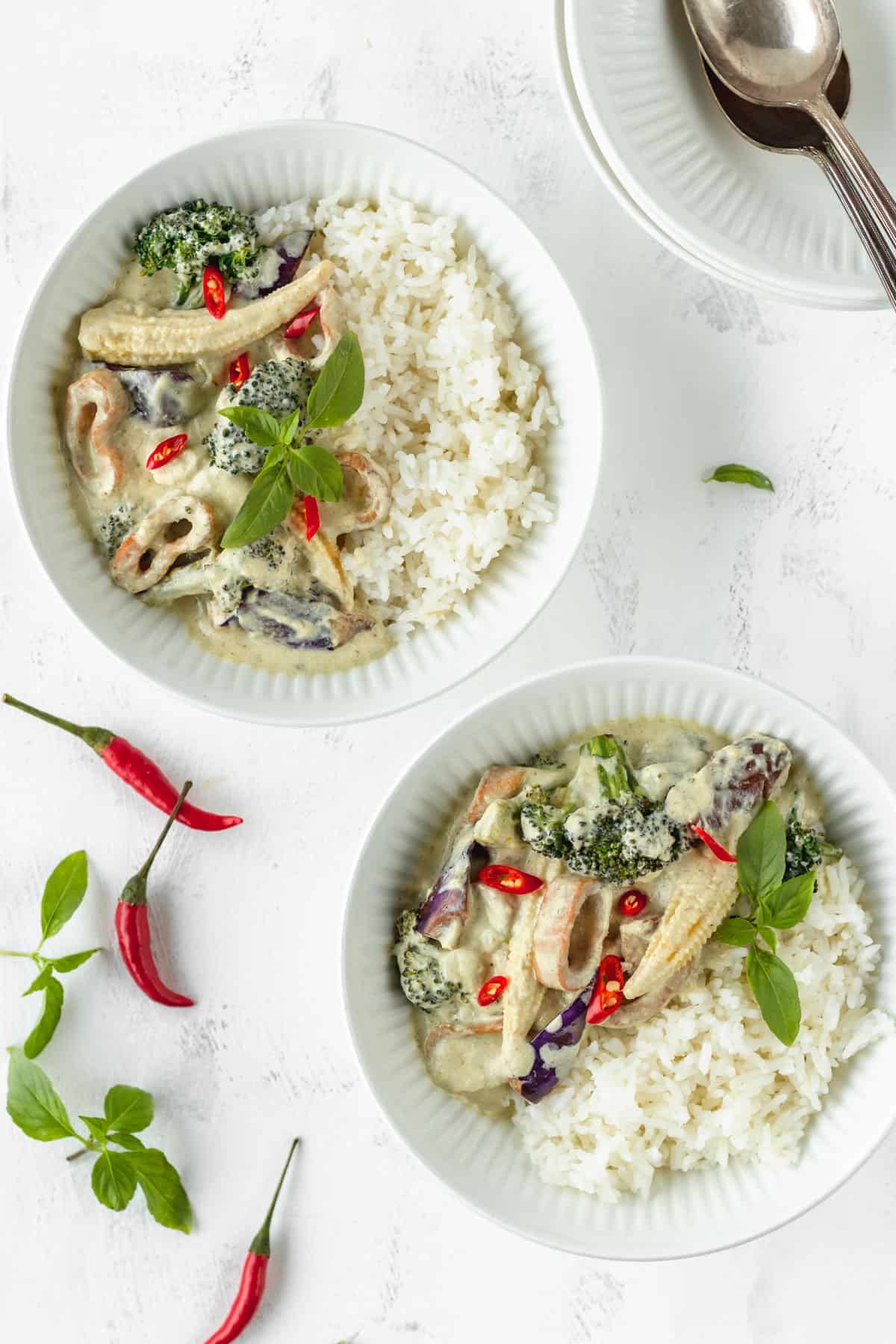
Explore More Delicious Vegan Curry Recipes
If you loved this vegan Thai green curry, you’re in for a treat! Discover more exciting plant-based curry dishes from around the world:
- Want more Thai curry inspiration with a twist? Try my vegan red curry mac and cheese for a fusion of comfort foods, or my Thai red curry ramen for a warming and flavorful noodle soup.
- If you’re craving ultimate comfort food with a Japanese flair, this vegan katsu curry is a must-try. Imagine hot, steamy rice topped with perfectly deep-fried vegan katsu and a rich, savory curry sauce.
- For those who prefer a less spicy curry experience, try this wonderfully creamy vegan coconut curry. It’s rich, comforting, and full of hearty winter vegetables, perfect for a cozy meal.
- These unique vegan potato croquettes are infused with curry paste for an unexpected flavor. They boast a crunchy golden exterior and a deliciously melty, cheesy center – a perfect appetizer or side dish.
- While this recipe focuses on vegan options, if you’re not vegan and enjoy seafood, you might also like this green curry salmon with broccoli from a fellow food blogger.
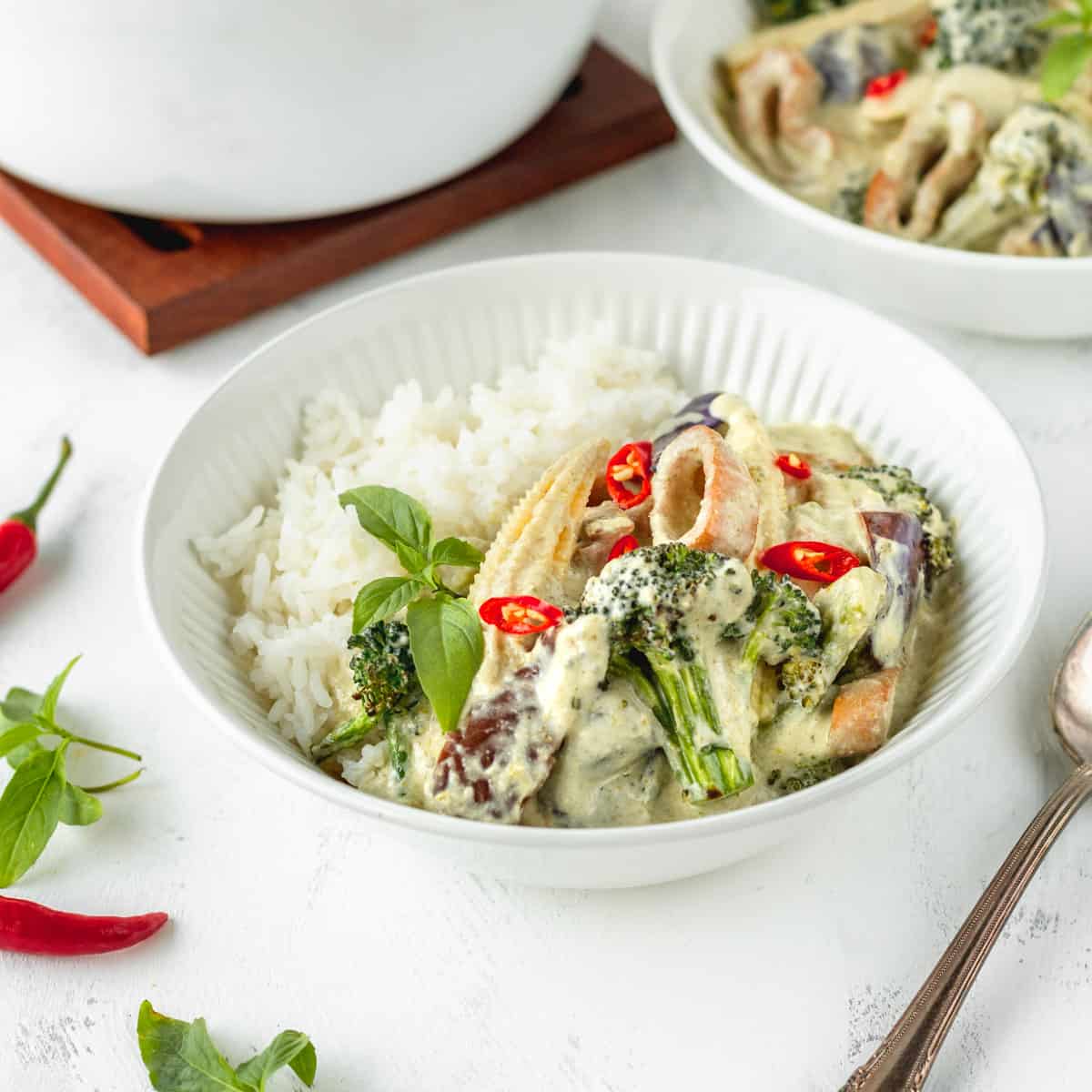
Vegan Thai Green Curry Recipe
Ingredients
- 4 tablespoons coconut oil
- 1½ cups chopped mushrooms
- 1½ cups cubed eggplant
- 2 cups broccoli florets
- 4 oz baby corn, sliced lengthwise
- 2 tablespoons green curry paste
- 13.5 fl oz full-fat coconut milk
- ¼ cup vegetable stock
- ¼ cup water
- ½ teaspoon fine sea salt
- 1 teaspoon sugar
- steamed jasmine rice
Instructions
- Rinse and chop the mushrooms and vegetables, and pat them dry with a paper towel.
- Heat 1 tablespoon of coconut oil in a skillet on medium heat. Sauté the mushrooms until lightly browned and take it out onto a plate.
- Add another 2 tablespoons of coconut oil, sauté the broccoli and eggplant, and take them out onto the plate once they’ve lightly browned.
- In a saucepan, heat 1 tablespoon coconut oil over medium heat and add the green curry paste. Sautée until fragrant, and add the coconut milk.
- Once it reaches a boil, add the stock, water, sautéed mushrooms and vegetables, and baby corn. Let the mushroom curry come to a boil, turn the heat down, and let it simmer for 5 minutes, or until it reaches your desired texture. Add the salt and sugar to taste.
